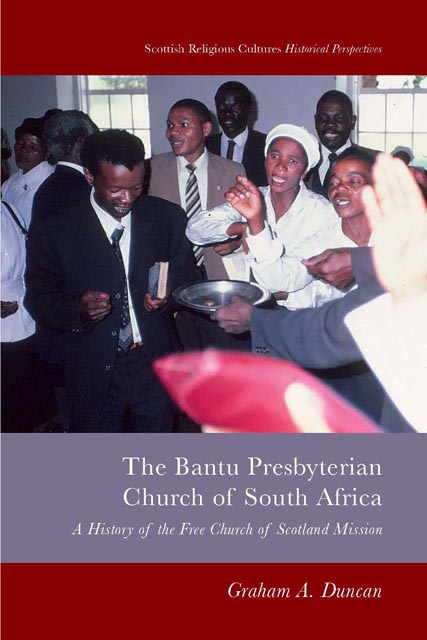Book contents
- Frontmatter
- Contents
- Acknowledgements
- Timeline
- A Presbyterian Anthem
- Introduction
- 1 Background to this Study
- 2 The Origins and Early Development of Scottish Presbyterian Mission in South Africa, 1824–65
- 3 Rev. Tiyo Soga (1829–71): A Paragon of Early Indigenous Leadership
- 4 The Role of Mission Councils in the Scottish Mission in South Africa, 1864–1923
- 5 The Rev. Edward Tsewu’s Dispute with the Free Church of Scotland Mission
- 6 The Mzimba Secession, 1898: A South African ‘Disruption’
- 7 Presbyterianism in South Africa, 1897–1923: To Unite orNot to Unite?
- 8 Preparations for the Formation of the Bantu Presbyterian Church of South Africa, 1897–1919
- 9 The Formation of the Bantu Presbyterian Church of South Africa, 1920–3
- 10 Mission to Church – Church to Mission: The First Ten Years, 1923–33
- 11 Reaching Out: The Bantu Presbyterian Church in South Africa and the Presbyterian Church of South Africa and Ecumenism, 1923–39
- 12 The Bantu Presbyterian Church in South Africa and Ecumenism, 1940–99
- 13 The End of Mission Councils: The Church of Scotland South Africa Joint Council, 1971–81
- 14 A Young Church in Mission or Maintenance Mode?: The Bantu Presbyterian Church of South Africa, 1923–99
- 15 The Bantu/Reformed Presbyterian Church and Socio-political Issues
- 16 Bantu/Reformed Presbyterian ChurchWomen in Leadership in Ministry
- Conclusion: Indigenous Presbyterians and Missionaries –Transferring Contending Roles and Responsibilities
- Bibliography
- Index
11 - Reaching Out: The Bantu Presbyterian Church in South Africa and the Presbyterian Church of South Africa and Ecumenism, 1923–39
Published online by Cambridge University Press: 26 November 2022
- Frontmatter
- Contents
- Acknowledgements
- Timeline
- A Presbyterian Anthem
- Introduction
- 1 Background to this Study
- 2 The Origins and Early Development of Scottish Presbyterian Mission in South Africa, 1824–65
- 3 Rev. Tiyo Soga (1829–71): A Paragon of Early Indigenous Leadership
- 4 The Role of Mission Councils in the Scottish Mission in South Africa, 1864–1923
- 5 The Rev. Edward Tsewu’s Dispute with the Free Church of Scotland Mission
- 6 The Mzimba Secession, 1898: A South African ‘Disruption’
- 7 Presbyterianism in South Africa, 1897–1923: To Unite orNot to Unite?
- 8 Preparations for the Formation of the Bantu Presbyterian Church of South Africa, 1897–1919
- 9 The Formation of the Bantu Presbyterian Church of South Africa, 1920–3
- 10 Mission to Church – Church to Mission: The First Ten Years, 1923–33
- 11 Reaching Out: The Bantu Presbyterian Church in South Africa and the Presbyterian Church of South Africa and Ecumenism, 1923–39
- 12 The Bantu Presbyterian Church in South Africa and Ecumenism, 1940–99
- 13 The End of Mission Councils: The Church of Scotland South Africa Joint Council, 1971–81
- 14 A Young Church in Mission or Maintenance Mode?: The Bantu Presbyterian Church of South Africa, 1923–99
- 15 The Bantu/Reformed Presbyterian Church and Socio-political Issues
- 16 Bantu/Reformed Presbyterian ChurchWomen in Leadership in Ministry
- Conclusion: Indigenous Presbyterians and Missionaries –Transferring Contending Roles and Responsibilities
- Bibliography
- Index
Summary
Introduction and Background
The Lord, indeed, as he has done from the beginning of the world, can wonderfully, in ways unknown to us, preserve the unity of the true faith, and prevent its destruction from the dissensions of men … I should with pleasure cross ten seas, if necessary, to accomplish that object. (Letter XVII, Calvin to Cranmer, Archbishop of Canterbury, 1552)
This quotation summarises the reforming view of ecumenism since the sixteenth-century Reformation. It reminds us that the sixteenth century Reformations were an attempt, following many earlier attempts, to reform a corrupt church. There was no desire to establish new churches but to follow in the Lord's intention from creation:
However, in the course of time, the Reforming tradition developed a ‘defective genetic tendency towards schism’ (a term coined by the late Presbyterian Prof. Calvin Cook, Rhodes University, Grahamstown; cf. Muirhead 2015: 1–3, Burleigh 1960: 457).
Following the Scottish Reformation it was many years before mission became a viable prospect. As we have already seen the beginnings of mission to South Africa were delayed until 1824. Before this mission depended on forces outside the formal structures of the church; hence, the growth and development of interdenominational voluntary societies. From 1824, the Free Church of Scotland engaged in mission in South Africa.
At the Disruption (1843), the Free Church of Scotland came into being as the result of secession from the Church of Scotland. This had a significant impact on the Scottish mission in South Africa. The Glasgow Missionary Society had been active in South Africa since 1821 and from 1834 ‘the disputes of Scotland made themselves felt though restrained by the allegiance to a greater cause’ (Drummond & Bulloch 1975: 166). In 1838 the Church of Scotland took responsibility for mission and subsequently ‘the Glasgow Missionary Society (GMS) adhering to the Principles of the Church of Scotland’ attracted five missionaries while the newly-formed Glasgow South African Missionary Society attracted two (Drummond & Bulloch 1975: 166).
- Type
- Chapter
- Information
- Bantu Presbyterian Church of South AfricaA History of the Free Church of Scotland Mission, pp. 137 - 148Publisher: Edinburgh University PressPrint publication year: 2022

